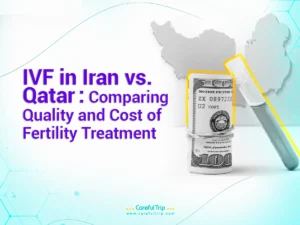
Compare Iran and Qatar for IVF
In the Middle East, the demand for assisted reproductive technologies like in vitro fertilization (IVF) has surged, driven by evolving societal norms and advancements in medical science. Among the countries leading this transformation are Iran and Qatar, each offering unique advantages to couples seeking fertility treatments. While both nations have invested heavily in healthcare infrastructure, their IVF approaches differ in cost, accessibility, and patient experience.
This comprehensive comparison delves into the nuances of IVF services in Iran and Qatar, examining factors such as treatment costs, quality of care, success rates, and overall patient satisfaction. By understanding these differences, prospective patients can make informed decisions aligned with their medical needs and financial considerations.
Introduction to IVF in the Middle East
The Middle East has witnessed a significant rise in infertility rates, prompting countries to enhance their reproductive healthcare services. IVF has become a beacon of hope for many couples, offering solutions where traditional methods fall short. Iran and Qatar, in particular, have emerged as prominent destinations for fertility treatments, attracting both local and international patients.
Iran boasts a long-standing history in reproductive medicine, with institutions like the Royan Institute leading groundbreaking research and clinical practices. The country’s emphasis on affordability and accessibility has made it a hub for medical tourism. Conversely, Qatar has focused on integrating advanced technologies and personalized care into its healthcare system, aiming to provide world-class services to its residents and expatriates.
Compare Iran and Qatar for IVF
1. Legal and Cultural Considerations
In Iran, IVF and related procedures like egg donation and surrogacy are permitted under Islamic law, provided they adhere to specific guidelines. The country’s religious authorities have issued fatwas supporting these treatments, ensuring they align with cultural and ethical norms. This legal framework has facilitated the growth of fertility clinics and research centers nationwide.
Qatar, while progressive in many aspects of healthcare, maintains stricter regulations concerning assisted reproductive technologies. Specific procedures, such as egg donation and surrogacy, face legal and cultural restrictions, limiting the range of services available to patients. These constraints can influence the options and success rates for couples seeking treatment in the country.
2. Accessibility and Infrastructure
Iran’s extensive network of fertility clinics, particularly in cities like Tehran, Shiraz, and Isfahan, ensures widespread access to IVF services. The integration of medical tourism into the healthcare system has further enhanced accessibility for international patients, with many clinics offering comprehensive packages that include accommodation and transportation.
Qatar’s healthcare infrastructure is centralized, with major facilities located in Doha. While the country has invested in state-of-the-art medical centers, the limited number of specialized fertility clinics can pose challenges in terms of appointment availability and personalized care.
Cost Comparison: Compare Iran and Qatar for IVF
1. Iran: Affordable Excellence
Iran is renowned for offering high-quality IVF treatments at a fraction of the cost compared to Western countries. The average cost of a basic IVF cycle ranges from $2,500 to $3,500, encompassing consultations, medications, and laboratory procedures. Additional services like egg donation or preimplantation genetic diagnosis (PGD) may incur extra charges but remain competitively priced.
2. Qatar: Premium Services at a Higher Price
In contrast, IVF treatments in Qatar are significantly more expensive. The cost of a single IVF cycle can range from $7,000 to $15,000, depending on the clinic and specific procedures involved. While the higher price point reflects the country’s investment in advanced technologies and personalized care, it may not be accessible to all patients, especially those without comprehensive insurance coverage.
Quality of Care and Clinics : Compare Iran and Qatar for IVF
1. Iran: Expertise Rooted in Research
Iran’s fertility clinics are staffed by highly trained specialists, many of whom have received international education and certifications. Institutions like the Royan Institute and MOM Fertility Center are recognized for their contributions to reproductive medicine, offering cutting-edge treatments and participating in global research initiatives.
2. Qatar: Modern Facilities with Personalized Care
Qatar’s medical centers are equipped with the latest technologies, ensuring patients receive top-tier care. Clinics emphasize personalized treatment plans, catering to the unique needs of each couple. However, the limited number of specialized fertility centers can impact the consistency and availability of services.
IVF Success Rates: Compare Iran and Qatar for IVF
1. Iran: Competitive Outcomes
Iranian fertility clinics report success rates comparable to global standards. For women under 35, the success rate ranges from 40% to 50%, decreasing with age. The country’s emphasis on research and adherence to international protocols contribute to these favorable outcomes.
2. Qatar: Data Limitations
While Qatar invests heavily in healthcare, specific data on IVF success rates are less publicly available. Anecdotal reports suggest success rates align with international averages, but the lack of transparent statistics makes direct comparisons challenging.
Patient Experience and Comfort
1. Iran: Holistic Medical Tourism
Iran offers a comprehensive medical tourism experience, combining high-quality medical care with cultural immersion. Patients often benefit from packages that include visa assistance, accommodation, and guided tours, enhancing their overall experience.
2. Qatar: Luxury and Convenience
Qatar provides a luxurious healthcare environment, with modern facilities and personalized services. The country’s infrastructure ensures comfort and convenience, particularly for residents and expatriates. However, the high cost and limited availability of specialized fertility services may affect the overall patient experience.
Which Country is Better for You?
Choosing between Iran and Qatar for IVF treatment depends on various factors, including budget, legal considerations, and personal preferences.
- Budget-Conscious Patients: Iran offers affordable, high-quality IVF treatments, making it an ideal choice for those seeking cost-effective solutions without compromising on care.
- Residents and Expatriates in Qatar: The convenience of local services and modern facilities may outweigh the higher costs for individuals already residing in Qatar.
- Patients Requiring Specific Procedures: Iran’s permissive legal framework allows for a broader range of fertility treatments, including egg donation and surrogacy, which may not be available in Qatar.
How CarefulTrip Can Assist in Your IVF Journey
CarefulTrip is a medical tourism facilitator specializing in connecting international patients with top-tier healthcare services in Iran. The organization offers comprehensive support throughout the IVF journey, including:
- Clinic Selection: Assisting patients in choosing reputable fertility clinics that align with their medical needs and preferences.
- Travel and Accommodation: Organizing travel logistics, including visa processing, transportation, and lodging arrangements.
- Language and Cultural Support: Providing translation services and cultural guidance to ensure a comfortable and stress-free experience.
- Post-Treatment Care: Coordinating follow-up appointments and offering ongoing support to monitor patient progress.
By leveraging CarefulTrip’s expertise, patients can confidently navigate the complexities of medical tourism and focus solely on their path to parenthood.
Final Words
The decision to pursue IVF treatment is deeply personal and often influenced by a myriad of factors, including medical needs, financial considerations, and cultural values. Both Iran and Qatar offer unique advantages in the realm of fertility treatments. Iran stands out for its affordability, comprehensive legal framework, and integration of medical tourism services. Qatar, while offering modern facilities and personalized care, presents challenges in terms of cost and the availability of certain procedures.
Prospective patients are encouraged to conduct thorough research, consult with medical professionals, and consider their individual circumstances when choosing the most suitable destination for IVF treatment.
References
- “IVF Treatment in Iran: Affordable, High-Quality Care.” https://tourteb.com/ivf-treatment-in-iran/
- Raadina Health. “IVF in Iran | IVF Treatment Cost in 2025.” https://raadinahealth.com/en/treatments/ivf
- Iran Health Agency. “IVF In Iran ✔️ | Process, Best Cost & Success Rate [2025].” https://iranhealthagency.com/services/ivf-in-iran/
- “Infertility Treatment in Iran for Couples.” https://carefultrip.com/blog/infertility-treatment-in-iran-for-couples-from-all-around-the-world/
- “Why Choose Iran for Infertility Treatment & IVF?” https://hayatmedtour.com/Blog/why-choose-iran-for-infertility-treatment/
